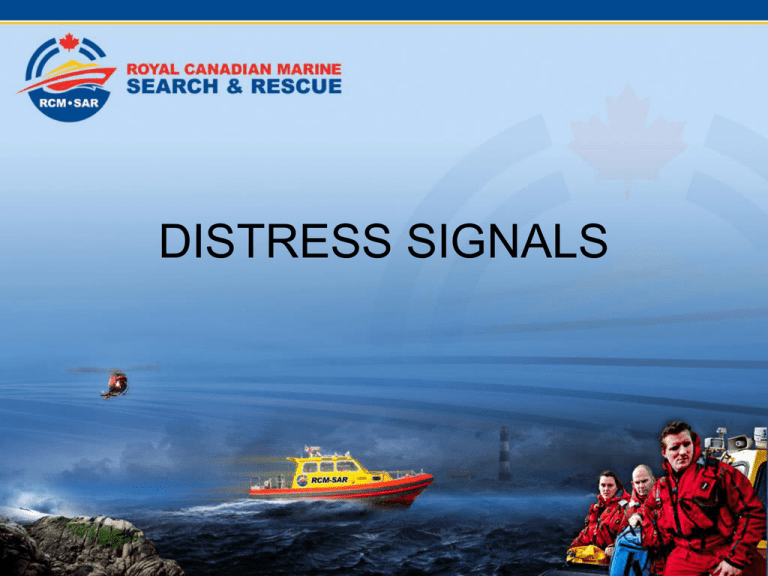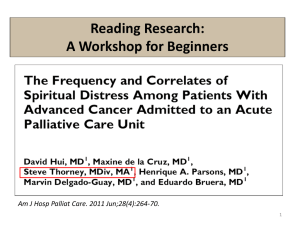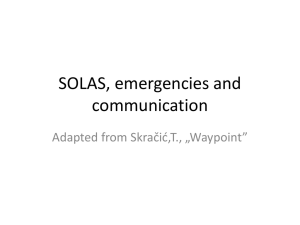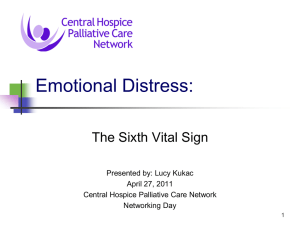03.7 Distress Signals & Pyrotechnics
advertisement

DISTRESS SIGNALS Distress Signals ANNEX IV of the International Regulations for Preventing Collision at Sea contains details of the International Distress Signals Distress Signals a) a gun or other explosive signal fired at intervals of about a minute; Distress Signals (b) a continuous sounding with any fogsignalling apparatus; Distress Signals (c) rockets or shells, throwing red stars fired one at a time at short intervals; 2 Star Red Rocket Distress Signals (d) a signal made by radiotelegraphy or by any other signalling method consisting of the group ...---... (SOS) in the Morse Code; Distress Signals (e) a signal sent by radiotelephony consisting of the spoken word "Mayday"; Distress Signals (f) the International Code Signal of distress indicated by N.C.; Distress Signals (g) a signal consisting of a square flag having above or below it a ball or anything resembling a ball; Distress Signals (h) flames on the vessel (as from a burning tar barrel, oil barrel, etc.); Distress Signals (i) a rocket parachute flare or a hand flare showing a red light; Parachute Red Rocket Pyrotechnics Miniflare 3 Red Hand Flare Distress Signals (j) a smoke signal giving off orange-coloured smoke; Smoke Float Distress Signals (k) slowly and repeatedly raising and lowering arms outstretched to each side; Distress Signals (l) the radiotelegraph alarm signal; Vessels in distress may use the radiotelegraph alarm signal or the radiotelephone alarm signal to secure attention to distress calls and messages. The radiotelegraph alarm signal, which is designed to actuate the radiotelegraph auto alarms of vessels so fitted, consists of a series of 12 dashes sent in 1 minute. Distress Signals (m) the radiotelephone alarm signal; This signal consists of two audio tones transmitted alternatively on the distress frequency 2182 kHz. This signal is similar in sound to a two-tone siren used by some ambulances. When generated by automated means, it shall be sent continuously as practicable over a period of not less than 30 seconds nor more than 1 minute. Distress Signals (n) signals transmitted by emergency positionindicating radio beacons; Distress Signals (o) approved signals transmitted by radiocommunication systems including survival craft transponders. The SOS 406 EPIRB satellite distress beacon designed to operate in conjunction with the COSPAS-SARSAT SART Locating Function Distress Signals 2. The use or exhibition of any of the foregoing signals except for the purpose of indicating distress and need of assistance and the use of other signals which may be confused with any of the above signals is prohibited. Distress Signals 3. Attention is drawn to the relevant sections of the International Code of Signals, the Merchant Ship Search and Rescue Manual and the following signals: Distress Signals (a) a piece of orange canvas with either a black square and circle or other symbol appropriate for identification from the air; and Distress Signals (b) a dye marker. Distress Signals Canadian Modifications 4. In Canadian waters or fishing zones, in addition to the signals described in section 1, the following signals may be used or exhibited either together or separately to indicate distress and need of assistance: Distress Signals Canadian Modifications (a) a square shape or anything resembling a square shape; and (b) a high intensity white light flashing at regular intervals of 50 to 70 times per minute. Distress Signals The following signals, used or exhibited either together or separately, indicate distress and need of assistance: Dual Frequency Personal Locator Beacons MCM 330 & SOS Rescue B Day & Night Signal Other Pyrotechnics Illuminating Flares The following signals are not distress signals Para Illuminating Rocket White Collision Handflare Line Throwing Apparatus This is carried by commercial ships. It is a rocket which carries a messenger rope to shore rescue authorities to send up breeches buoy to evacuate crew.








